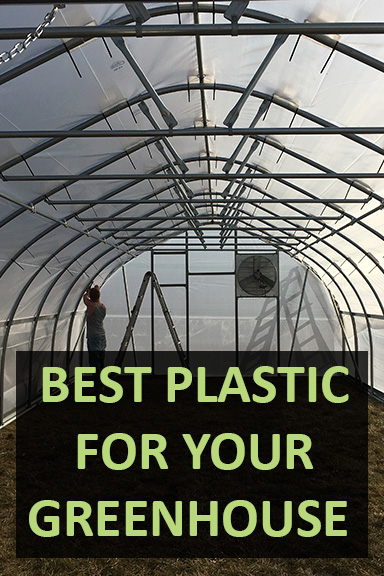Best Greenhouse Plastic | Comparing through First Hand Experience

Greenhouse structures can be covered with a wide variety of materials, but not all companies carry the best types of greenhouse plastic. Whichever film ends up on your structure three things are certain:
- Greenhouse plastic affects the growth and health of plants
- The type of greenhouse plastic used dictates when a replacement cover is required
- Different coverings come with different required labor inputs
Simply put, the type of greenhouse plastic you select will absolutely impact plant quality, as well as how much time you spend installing and replacing plastic through the life of your structure.
So... how should we select greenhouse plastic for our structure?
What greenhouse plastic lasts longest?
In this post, we are going to do the best we can to provide detailed information that will help you select the best greenhouse plastic for your operation.
Our Favorite Greenhouse Plastic Covers are...
Based on thousands of hours working with (and installing) various greenhouse plastics, we have chosen our favorites. Our choices are based on material life-span, price, availability, and technical specifications. If you want to see our reasoning in MUCH more detail keep reading through the rest of this post, but if you are in a hurry, here are the best available greenhouse plastics for most growing applications:
Best Budget Greenhouse Plastic: UVA Clear 4 yr. 6 mil Greenhouse Plastic
Best Anti Drip Greenhouse Plastic: Anti-Drip 4 yr. 6 mil Greenhouse Plastic
Best End-Wall Greenhouse Plastic: Clear 12 mil Woven Greenhouse Plastic
Best Hard End-Wall Covering: 8 mm Twin Wall Polycarbonate Sheeting
The 6 mil plastics are often cut-to-order, but there are often a variety of Pre-Cut 6 mil sizes available.
The above are recommended greenhouse plastics based on each option having a TON of value for the cost, as well as for how long each option can last before needing replaced. They are also recommended based on our direct experience.
We've handled all of these plastic films, and know for a certainty they will work well as suggested.
While we feel the plastics recommended above are fantastic, there are other great options outlined through the rest of this post that might be more ideal for some operations.
Let's compare greenhouse plastics in more detail below.
How to Compare Greenhouse Plastics
The recommendations for greenhouse plastic we make are based on more than a decade of installing and handling hundreds of covers on a variety of greenhouses, high tunnels, and hoop houses.
In order to outline the best greenhouse plastic for your needs it is first necessary to learn how to compare greenhouse plastics.
Three Categories to Base Greenhouse Plastic Comparisons
While a variety of manufacturers make Greenhouse Plastic, their products typically fall within a few common categories.
These categories can be used to help narrow down which plastics are best for you:
- Technical specs: How much light transmission and diffused light pass through?
- Durability: How difficult is it to puncture holes through the plastic?
- Expected lifespan: How many years will the greenhouse plastic last?
The greenhouse plastics we recommended at the beginning of this post weighed all of the above categories against each other, but if you care more about one of the listed categories than the other, it is certainly possible to make a greenhouse plastic selection based solely on one or the other.
Whether you use one category to make a decision, or you weigh all of your options, looking into the different ways to compare the plastic films is a great way to begin narrowing things down.
Below we go through the three main ways to compare greenhouse plastic, and while we come to our own conclusions for the best greenhouse plastic above, you may find that a different type of covering meets your needs better. .
1. Comparing Greenhouse Plastic Technical Specs
Greenhouse films have slightly different technical specifications. The technical specs most often used for making comparisons are outlined below:
Light Transmission: How much light can pass through the plastic and onto plants
Diffused Light Percentage: The spread of light that passes through the plastic
Anti Drip Properties: Can the plastic reduce the amount of internal dripping on plants
While other technical specs are available for most greenhouse plastics it becomes more and more difficult to compare those specifications across all plastics.
| Type of Greenhouse Plastic | Light Transmission % | Diffused Light % | Anti Drip |
| SolaWrap Covering | 83% | 83% | Yes |
| Polycarbonate, 8mm Twin Wall | 79% - 81% | N/A | Yes |
| 12 mil Greenhouse Plastic | 80% | 82% | No |
| 12 mil Greenhouse Plastic, Anti Drip | 80% | 82% | Yes |
| 9 mil Greenhouse Plastic, Anti Drip | 87% | 63% | Yes |
| 6 mil Clear Greenhouse Plastic | 90% | 22% | No |
| 6 mil IRAD Greenhouse Plastic | 89% - 90% | 25% | Yes |
| Cover Plus Overwintering, 4 mil | 30% or 45% | N/A | No |
| Overwintering Plus Film, 3 mil | 30% | N/A | No |
| Standard Overwintering Film | 30%, 45%, or 90% | 20% | No |
Source: individual specification sheets from various manufacturers and suppliers
The above list of covers is not exhaustive; there are countless cover options available for every type of grower.
The above list does provide a comparison of the most widely used plastic coverings on the market though.
Other Important Technical Specs
While light transmission, diffusesd light, and anti drip are the most commonly compared technical specs of greenhouse plastic they are not the only ones worth knowing.
For those installing heaters, or maximum heat retention it is also important to look into the plastic coverings R-value.
R-Value
Essentially, a value is given to coverings in order to show how well it resists the flow of heat.
For all objects with an R-value, the higher the value the better its ability to resist heat transfer.
In the world of greenhouse plastics most pliable plastics have negligible values associated with them. There are however some greenhouse plastics that do have notable R-values:
SolaWrap Covering: R-value = 1.7
Polycarbonate, 8mm Twin Wall: R-value = 1.7
Double Layer Inflated Greenhouse Plastic: R-value = 1.42 (Source: Vermont Edu)
The last example listed above is a HUGE deal. The reason... Double layer inflated greenhouse plastic systems take two layers of economy plastic, and add an inflation blower fan in order to create better insulation and a higher R-Value... all while using lower cost greenhouse plastic.
2. Most Durable Greenhouse Plastics
Many growers base 100% of their greenhouse plastic purchasing on how durable the greenhouse plastic is.
In other words, light transmission stats and cost are thrown to the side, and most attention is paid to which plastic can hold up to wind, rain, hail, and years of sunlight.
All of the coverings we've discussed in this post (so far) do a great job in inclement weather, but there are a few notable winners when it comes to being able to withstand a beating.
Below I note the comparable durability of each major greenhouse plastic covering.
Strength of 6 mil Greenhouse Plastic
This greenhouse plastic is the most popular for a reason.
Of the durable plastics covered here it is the least costly.
6 mil greenhouse films can take a beating, and while it is not as durable as woven greenhouse plastics, SolaWrap, or Twin Wall Polycarbonate, it is likely the most forgiving of the plastics.
In other words, this plastic can move a ton in the wind, and can hold a ton of weight without breaking or busting.
It is, however, much easier to puncture than any of the other plastics detailed in this section. Something to keep in mind if you live in an area where wind could blow branches or sticks toward your structure.
Strength of Woven Greenhouse Plastics
Woven greenhouse plastics are, for the most part, stronger than 6 mil greenhouse plastics.
They aren't as stretchable, and for this reason it is more difficult to pull all of the tension out of these plastic coverings. For this reason, these covers might move more in the wind over their extended life if not installed well.
With this being said, they are very difficult to puncture and can hold a lot of weight. Many woven greenhouse films can hold many multiples more than 6 mil greenhouse plastic.
Strength of SolaWrap Greenhouse Plastic
SolaWrap is a unique covering option because it comes in very long rolls that are very narrow. This means it must be installed in a completely different ways than pretty much every other covering option on the market.
Ultimately, the SolaWrap covering is installed and attached to every single bow of a structure. This compounds how durable and strong the SolaWrap covering is, because the plastic connects directly to the frame of your structure every 4 ft. or 6 ft.
Because a permanent attachment is made every 4 ft. or 6 ft. through your structures length, it will not move as much in horrible winds. This, when combined with its thickness and durable outer coating make SolaWrap the most durable all-purpose greenhouse plastic on the market.
Strength of Twin Wall Polycarbonate Plastic, 8 mm
8 mm Twin Wall Polycarbonate is extremely durable, and is very difficult to puncture and impossible to tear.
It is nearly impossible to break the stuff in half too. Take it from me, I have tried.
While 8 mm Twin Wall Polycarbonate sheeting is stronger than standard plastic coverings it is a hard glazing so it can, unfortunately, dent. Because it can dent in some scenarios, twin wall polycarbonate is often the covering of choice for end-walls, but not installed on the tops of structures.
3. Comparing by Greenhouse Plastic Lifespan
This is where many customers usually start their search for greenhouse plastic. Which greenhouse plastic will last the longest?
Whether a grower or builder, it makes a lot of sense to compare greenhouse plastics by the number of useful years you'll get out of it. Trying to source a greenhouse plastic with the longest possible lifespan does indeed make a lot of sense.
We go into much more detail below, but the chart here can be used to compare the lifespans of different greenhouse covers.
| Type of Greenhouse Plastic | Expected Lifespan | Relative Cost |
| SolaWrap Covering | 10 - 15 + years^ | Very High |
| Polycarbonate, 8mm Twin Wall | 10 - 15 + years^ | High |
| 12 mil Woven Greenhouse Plastic | 4 - 8 years | Medium |
| 9 mil Woven Greenhouse Plastic | 4 - 8 years | Medium |
| **6 mil Greenhouse Plastics | 4 - 6 years | Low |
| Cover Plus Overwintering, 4 mil | 2 - 3 years | Low |
| Overwintering Plus Film, 3 mil | 1 - 2 years | Low |
| Standard Overwintering Film | 0 - 1 year | Very Low |
**Best all around value
^Both have 10 year manufacturer warranties, but real world case studies have shown 15 - 20 plus years
Lifespan vs Cost of Greenhouse Plastic
Most often there is a trade off between expected lifespan and the price of greenhouse plastic.
Plant nurseries, for example, will often use what is referred to as overwintering plastic. This type of plastic is VERY inexpensive compared to other types of greenhouse plastic. The trade off being overwintering poly has a very short lifespan.
Overwintering greenhouse plastic is covered in more detail a bit further down in the post, but I wanted to mention it here because it demonstrates the main trade off of plastic.
Below I provide a list of expected life span's, as well as the type of greenhouse plastics that meet those specs.
Expected life of common greenhouse plastics
Let's breakdown the types of greenhouse plastic based on how long they are expected to last.
Below we move through the various greenhouse plastics, from the shortest lifespan to those with the longest useful life.
Plastic Films Lasting Between 0-1 years
Overwintering Greenhouse Plastic (available in a variety of thicknesses)
Lasts approximately 1 year, and as the name would suggest it is primarily used for overwintering plants.
The common characteristics of this plastic is that it's cheap.
Overwintering film is divided into clear and white film primarily, although some other colors are available. Unless the film is clear, overwintering plastics have a much lower light transmission. Keep this in mind if you want to order overwintering plastics
Greenhouse Plastic Lasting 1-2 years
Overwinter Plus Greenhouse Plastic, 3 mil
Overwinter Plus Greenhouse Plastic is very similar to the overwinter film I mentioned above, but it has been manufactured in a way that makes it much stronger than standard overwinter film.
Due to the manufacturing process this film will last double what a standard overwintering film will last, and it comes in a variety of thicknesses. The main attributes of this film is that it is still relatively cheap. It is also offered in both clear and white colors.
Greenhouse Plastic Lasting 2-3 years
Cover Plus Greenhouse Film, 4 mil
For those needing a little bit longer out of there overwintering films there is a few types of overwinter plus film that are not only manufactured to be stronger, but they are manufactured to be a little thicker. These overwinter plus films can last between two and three years. There are a variety of colors available for overwinter plus film, but the most widely used are white and clear. Technical specs on light transmission, diffused light percentage, and break strength are outlined further down in this post.
Greenhouse Poly Lasting 4-6 years
Greenhouse Plastic, 6 mil
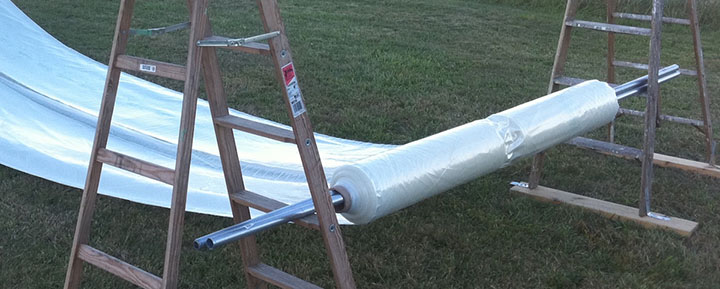
Typically, six mil greenhouse plastic is the most trusted and widely used among the different varieties of greenhouse plastic. Since 6 mil Greenhouse Plastics are the most commonly used coverings this is what most all greenhouse covers are compared against.
6 mil plastic is the industry baseline.
The lifespan, fit, and ease of installation is what sets the 6 mil plastic apart from other varieties of covers. While the expected lifespan is 4 years I have seen a number of these covers make it as long as seven years without being replaced.
There are a variety of six mil greenhouse plastics, and all have a range of technical specs, which we use for comparison purposes further on in this post.
I will go into the technical specs when comparing on those grounds further on in this post, but for now here are the four most common six mil greenhouse films, along with a brief sentence about their main qualities:
Clear Greenhouse Plastic, 6 mil
This is the economy line of 6 mil greenhouse plastic, and while it is still projected to last four years, it doesn't have many additives applied during the manufacturing process. This isn't necessarily a bad thing, although it does mean you would forego anti-drip properties if you went with this covering.
This plastic also allows the most light transmission of any of the six mill plastic.
Anti-Drip Greenhouse Plastic, 6 mil
This plastic covering is likely the second most popular greenhouse plastic on the market, and this is primarily due to the additives used in its manufacturing process that give it properties to help with internal condensation (Anti-Drip), as well as provide a higher thermicity percentage, which is attributed to holding in warm air.
Diffused Greenhouse Plastic, 6 mil
This plastic is intentionally manufactured to provide a higher percentage of diffused light. What this means is that a set amount of light gets disbursed more fully when passing through this plastic.
This plastic is ideal where greenhouses are densely packed with plants. In scenarios where hanging baskets, or very heavy foliage exists. Diffused plastic can hit more of the densely planted foliage.
White Greenhouse Plastic, 6 mil
For the growers wanting a multi year overwintering film, as well as a thicker longer lasting option, six mill white greenhouse plastic is for you. Being white this plastic has a lower light transmission, and it is also a low-cost plastic that is similar to the clear variety in this thickness.
Plastic Films Lasting 4 - 8 years
Polyweave Woven Greenhouse Plastic
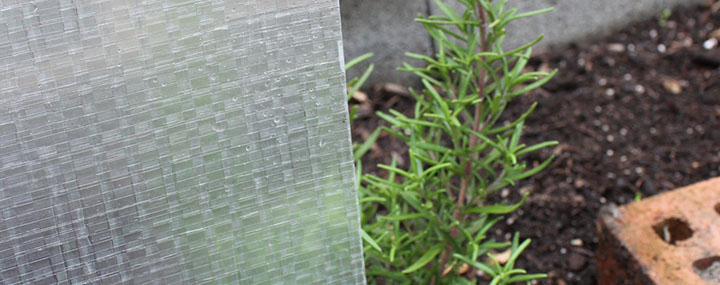
This type of greenhouse plastic is in a completely different pillar than the overwintering and six mil greenhouse plastic. These plastics appear to be woven, although it should be noted that water cannot get through the greenhouse plastic. There were an appearance is an attribute that helps create a sticker more durable plastic covering, as well as a greenhouse plastic that has a much higher break and tear point. Many of these covers can handle over 100 pounds of pressure per square foot. Here are the main types of polyweave woven greenhouse plastics:
9 mil Clear woven greenhouse plastic
Heavy duty, thick, durable greenhouse plastic that is the most streamlined and affordable of the woven poly greenhouse plastics. The highest light transmission of the woven plastics, and a respectable diffused light percentage as well.
9 mil Anti-Drip woven greenhouse plastic
The composition of 9 mil anti-drip greenhouse plasticisn't all that different from the clear woven greenhouse plastic. Both the clear and the anti-drip have similar expected lifespans. Although the anti-drip layering has been added to this plastic covering there aren't any great extensions to the expected lifespan of the plastic.
12 mil Clear woven greenhouse plastic
Similar to 9 mil plastic in that minimal additives are used in its manufacturing process, which results in plastic with out anti-drip properties, however it's increased durability and weight bearing capacity makes this plastic a valued greenhouse cover.
With a slightly lower light transmission when compared to 9 mil greenhouse plastic, this covering is often used on the end walls of structures as well as the roll-up sides.
12 mil Anti-Drip woven greenhouse plastic
With the same durability and weight bearing capacity of it's clear counterpart, this cover offers a highly durable greenhouse plastic that was manufactured to include additives that prevent condensation from dripping on plants on the interior of the structure.
In order to fully see the benefits of an anti-drip plastic, however, it should be noted that this cover should be the bottom / interior layer of greenhouse plastic in a double layer insulated greenhouse plastic set up.
If you are on the fence about installing a double layer inflated greenhouse plastic system,you may want to check out this article, Why Install a Double Layer Inflation System for Your Greenhouse.
Your top layer of greenhouse plastic should be a standard 6 mil clear greenhouse plastic if this were to be your set up. This is primarily due to the fact that 12 mil or 9 mil greenhouse plastic is very heavy, and would put undue stress on insulation blower motors.
Greenhouse Plastic That Can Last 10 - 15 years +
Twin-wall Polycarbonate Sheeting, 8 mm
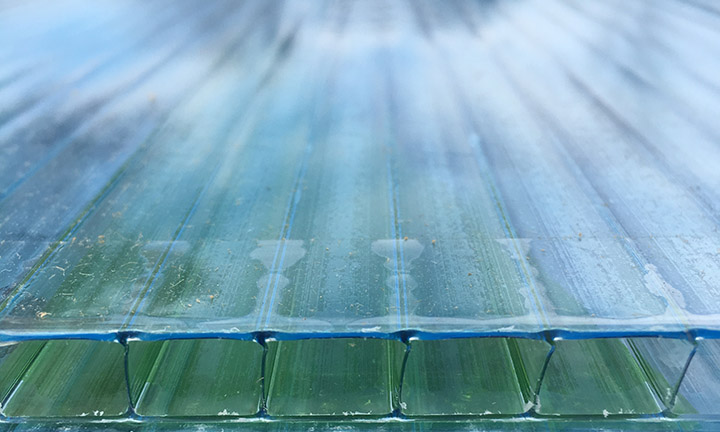
While this post focuses primarily on pliable top cover greenhouse plastics, we would be neglectful to omit one of the highest quality greenhouse plastics in the industry. There are a wide variety of polycarbonate covers, however, Many of them lack the R-value of an 8 mm twin-wall polycarbonate.
Made of a hard acrylic, and with its own manufactured dead air space as a part of each sheet, this greenhouse plastic is both able to fight wind, and provide true temperature benefits to the plants inside your structure.
Due to this greenhouse plastic being solid in composition, as well as long lasting, it is often much costlier than pliable greenhouse cover options.
Other 10 - 15 years + Greenhouse Poly
SolaWrap Greenhouse Plastic
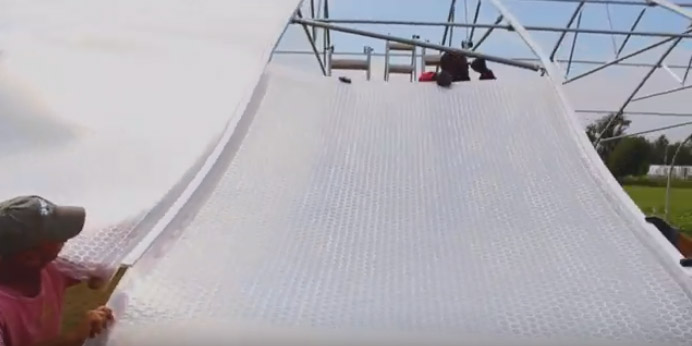
This type of plastic is relatively new to the US market. Unlike any of the other greenhouse plastic listed here, this greenhouse plastic covering is somewhere in between a solid polycarbonate sheeting, and a pliable greenhouse plastic.
Very durable in nature, and insulated with a large number of repeating air bubbles, this greenhouse plastic is rated to last 10 to 15 years, and comes with a manufacturers warranty of 10 years.
Due to its longevity, and it's insulating properties this greenhouse plastic does tend to be much more costly than its competition. For this reason, SolaWrap needs to be scrutinized through a cost benefit analysis for each particular structure it is planned to be installed on.
For example, one who is thinking about using SolaWrap MUST:
- Determine what crops are going to be grown in the structure
- Determine what kind of operating expenses will go into producing those crops throughout the lifespan of the structure
- Determine the overall expected revenue from the structure
- Weigh the expected revenues against the investment required to use SolaWrap
Based on the above, see if you are able to develop a month-to-month plan to ensure your monthly revenues can justify the additional cost of the SolaWrap covered structure.
This will provide a basis for you to make a solid economic argument for the purchase (or not) of this product.
If you are using propane or natural gas heat in your structure, the monthly expenses will be greater. SolaWrap's supreme R-Value could provide monthly savings in fuel that speed up it's "Pay-Back-Period".
These reduced monthly heating expenses could be enough to help make an argument for using SolaWrap covering.
Making a Final Decision on a Greenhouse Plastic
It may seem difficult to decide on which plastic is best for your operation when there are so many options.
Not only are there countless options for your covering... there are many different ways to judge the coverings.
One type might have high light transmission it may lack a high R-value; one might last 15 years, but cost an arm and a leg. These trade offs should be weighed against each other when deciding.
While the SolaWrap film is likely the best all around greenhouse plastic based on technical specifications, and expected lifespan, its relatively high cost when compared to other covers make it difficult to recommend.
For most, a lower cost (and widely used) 6 mil film or 9 mil covering will work great.
Hopefully this post has helped you navigate the sometimes overwhelming world of greenhouse plastic coverings... Now you can source a film to cover your structure(s) with confidence.
You can learn more about how to cover your structure with greenhouse plastic by checking out our blog post where we go over EVERYTHING you need to know when covering your structure with greenhouse plastic.
RELATED POSTS
- How to Determine What Size Greenhouse Plastic You Need
- 3 Best Backyard High Tunnels for Home Growers
- How to Install Greenhouse Plastic Cover
- 10 Crucial Hardware Components for Greenhouse Builds
- 9 of the Best Winter Crops for a High Tunnel
- 4 Ways to Attach Greenhouse Plastic to a Metal Frame
